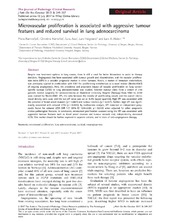| dc.contributor.author | Ramnefjell, Maria | en_US |
| dc.contributor.author | Aamelfot, Christina | en_US |
| dc.contributor.author | Aziz, Sura Mohammed | en_US |
| dc.contributor.author | Helgeland, Lars | en_US |
| dc.contributor.author | Akslen, Lars A. | en_US |
| dc.date.accessioned | 2018-08-28T09:54:10Z | |
| dc.date.available | 2018-08-28T09:54:10Z | |
| dc.date.issued | 2017-10 | |
| dc.Published | Ramnefjell M, Aamelfot C, Aziz S, Helgeland L, Akslen LA. Microvascular proliferation is associated with aggressive tumour features and reduced survival in lung adenocarcinoma.. The journal of pathology. Clinical research. 2017;3(4):249-257 | eng |
| dc.identifier.issn | 2056-4538 | |
| dc.identifier.uri | https://hdl.handle.net/1956/18291 | |
| dc.description.abstract | Despite new treatment options in lung cancer, there is still a need for better biomarkers to assist in therapy decisions. Angiogenesis has been associated with tumour growth and dissemination, and the vascular proliferation index (VPI) is a valuable prognostic marker in other tumours. Nestin, a marker of immature endothelium, was previously applied in combination with Ki67 for proliferating endothelium as a novel marker (Nestin‐Ki67) of ongoing angiogenesis. Here, the prevalence and prognostic impact of vascular proliferation on lung cancer‐specific survival (LCSS) in lung adenocarcinomas was studied. Selected tumour slides from a cohort of 210 patients treated surgically for adenocarcinoma at Haukeland University Hospital (Norway) from 1993 to 2010 were stained for Nestin‐Ki67. VPI, the ratio between the density of proliferating vessels and the overall microvessel density were used, and the cut‐off value was set at 4.4% (upper quartile). High VPI was associated with the presence of blood vessel invasion (p = 0.007) and tumour necrosis (p = 0.007). Further, high VPI was significantly associated with reduced LCSS (p = 0.020). By multivariate analysis, VPI remained an independent prognostic factor for reduced LCSS (HR 1.7; 95% CI 1.04–2.68; p = 0.033) when adjusted for other prognostic clinico‐pathological features. In conclusion, microvessel proliferation assessed using the VPI was associated with aggressive tumour features such as blood vessel invasion and tumour necrosis and, independently, decreased LCSS. This marker should be further explored in separate cohorts, and in trials of anti‐angiogenesis therapy. | en_US |
| dc.language.iso | eng | eng |
| dc.publisher | Wiley | eng |
| dc.rights | Attribution CC BY-NC-ND | eng |
| dc.rights.uri | http://creativecommons.org/licenses/by-nc-nd/4.0/ | eng |
| dc.subject | microvessel proliferation | eng |
| dc.subject | lung adenocarcinoma | eng |
| dc.subject | Survival | eng |
| dc.subject | neoangiogenesis | eng |
| dc.title | Microvascular proliferation is associated with aggressive tumour features and reduced survival in lung adenocarcinoma | en_US |
| dc.type | Peer reviewed | |
| dc.type | Journal article | |
| dc.date.updated | 2018-03-07T10:53:46Z | |
| dc.description.version | publishedVersion | en_US |
| dc.rights.holder | Copyright 2017 The Author(s) | |
| dc.identifier.doi | https://doi.org/10.1002/cjp2.78 | |
| dc.identifier.cristin | 1543325 | |
| dc.source.journal | The journal of pathology. Clinical research | |

